Spearpoint 1943
MFG Code: CEW00004 (Click for Store Link)
MSRP: $29.95 USD
- Overview
- Details
- Learn to Play
- Downloads
- Reviews
- Gallery
- FAQ
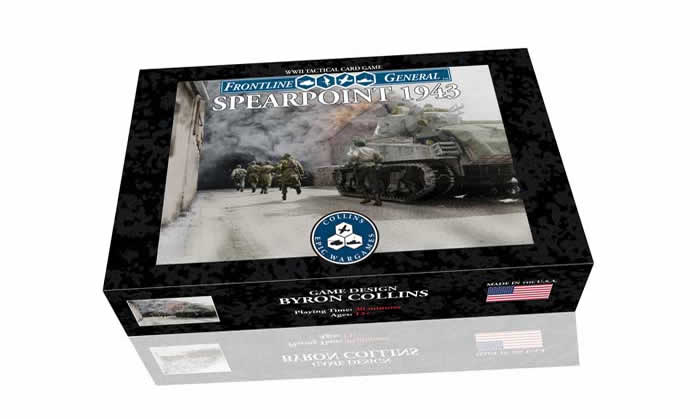
Spearpoint 1943 is a fast-paced two-player tactical card wargame set in WWII. Spearpoint focuses on WWII frontline combat, chaos, tension, and fun. 100 Unit Cards feature an assortment of historical German and US squad level infantry, artillery, armor, and aircraft. 50 Command Cards give support and intel to players. 25 Damage Cards apply unique Damage Effects if a unit becomes damaged. Combat is quick and tense and resolves using four included D10 dice. Standard and Situation games play in about 30 minutes including setup.
Contents:
- 175 Cards
- 4 D10 Dice
- 1 Sheet of Rules
Find out more about this game under Details.
Download Situations, Rules, an FAQ, Score Sheet, Tuck Box Templates, and more in the Spearpoint 1943 Downloads section.
Buy the game through your favorite local game store or direct through Collins Epic Wargames. Available worldwide.
Expand the game with Frontline General: Spearpoint 1943 Village and Defensive Line Map Expansion and Spearpoint 1943 Eastern Front
Designer: Byron Collins
Artwork: Byron Collins (game), Mark Mahaffey (box)
Spearpoint 1943 is a WWII tactical card game focusing on battles between US and German forces in Italy during 1943. The game is in a compact box which allows for easy transport to your next gaming night. Inside that box, you’ll find 175 cards, four d10s (two grey and two blue), and the rules sheet. The cards are broken into four decks: 50 cards make up the US deck, 50 for the Germans, 50 Command cards, and 25 Damage cards. The US and German cards are called Units and they include equipment such as tanks, guns, aircraft, infantry, and the crews required for certain equipment.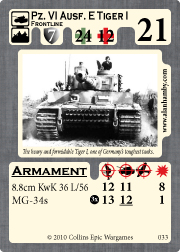
A Standard Game begins with each side choosing cards totaling 80 to 100 points, which makes up your Reserves Deck. The remaining Unit cards are placed to the side as they will not be used. Each side has 284 points worth of unit cards to choose from so you have loads of choices regarding deck construction. Unit Card point values range from 2 points for a crew to 21 points for the powerful German Tiger I. These point values are also their value to the opposing side if destroyed.
Once you have constructed your deck, you’ll choose four Unit Cards to keep as your starting hand, Shuffle your remaining Reserves, and draw three Command cards. Starting forces begin in your hand and the rest make up your Reserves. At this point the first Commitment Phase begins. You may commit up to your entire hand during any Commitment Phase, which effectively brings units into the Battle Area and into engagement range. Committed units come into play either on the frontline or the rearline, as indicated by the Unit Card under the Unit's Title. Frontline Units typically include infantry, tanks, short range guns, etc., while Rear Line Units may include Artillery or Self-Propelled Guns. Aircraft are not committed to a line, but rather, come into play for a set number of turns based on their actual fuel capacity. Multiple lines provide a sense of depth and allow for breakthrough actions with aircraft screaming overhead.
The Combat Phase begins by each player simultaneously declaring the targets of each of his Units in play. To do this, players simply point each card toward its intended target within the restrictions of targeting. For example, each Unit Card has 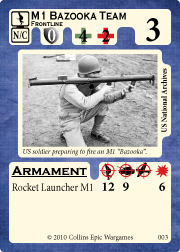 one or more weapons listed. If an attack value is given for that weapon that corresponds with the Unit Type Icon, the attack is legal. Once targets are set, each player rolls a d10 for Initiative. The highest roll will attack first with one of their units. Since damage is instantaneous (i.e. you can destroy a unit before it has a chance to fire), Initiative is an important roll. Attacks alternate from there until all previously declared attacks are resolved this Combat Phase. To hit a target in an attack, the attacker will roll 2d10, adding or subtracting any modifiers, sum the result, and compare it to a hit number provided on the attacking unit’s card under the weapon in use. Most units have more than one weapon that can be used and you’ll choose which to use based on target type: infantry, artillery / armor, or aircraft. Each Unit may fire 2 weapons per turn against a single target. There are rules for critical hits (sum of 18, 19, 20) that result in extra damage or instant destruction as well as critical misses (sum of 2 or 3) that result in friendly fire.
one or more weapons listed. If an attack value is given for that weapon that corresponds with the Unit Type Icon, the attack is legal. Once targets are set, each player rolls a d10 for Initiative. The highest roll will attack first with one of their units. Since damage is instantaneous (i.e. you can destroy a unit before it has a chance to fire), Initiative is an important roll. Attacks alternate from there until all previously declared attacks are resolved this Combat Phase. To hit a target in an attack, the attacker will roll 2d10, adding or subtracting any modifiers, sum the result, and compare it to a hit number provided on the attacking unit’s card under the weapon in use. Most units have more than one weapon that can be used and you’ll choose which to use based on target type: infantry, artillery / armor, or aircraft. Each Unit may fire 2 weapons per turn against a single target. There are rules for critical hits (sum of 18, 19, 20) that result in extra damage or instant destruction as well as critical misses (sum of 2 or 3) that result in friendly fire.
If the attack is a hit, the Intensity of that attack (representing how well-placed the shot was) is determined with a d10, which is added to the base damage factor of the weapon that scored the hit. The defense value of the target is subtracted from the total damage and what is left is applied to the target's Endurance. Each unit has an amount of damage that it can sustain and if the break number is reached (normally half of the full Endurance) a Damage Card is drawn and the extra effects are applied to the target. 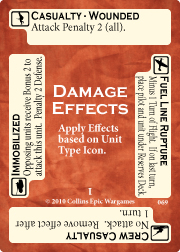
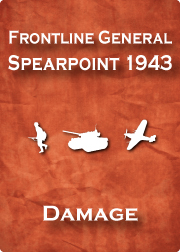 It’s important to at least reach that break number when you attack a unit because damage points do not carry over from turn to turn. In other words, damage in a turn is cumulative but once that turn is over the target is either damaged (and marked with a Damage Card) or returned to full strength (with damage shaken off).
It’s important to at least reach that break number when you attack a unit because damage points do not carry over from turn to turn. In other words, damage in a turn is cumulative but once that turn is over the target is either damaged (and marked with a Damage Card) or returned to full strength (with damage shaken off).
Combat and damage resolution moves smoothly after a few turns. At first, it may seem confusing, but you’ll get the hang of it and the pace of the game definitely speeds up - especially as things begin blowing up.
The Final Phase of each turn is called the Draw Phase. Players each draw a single Command Card from a common deck, and then choose to draw any two additional cards - these can be two Unit Cards, two more Command Cards, or one of each.
Command Cards are used when appropriate (according to the card) to throw a lot of wrinkles into the game. 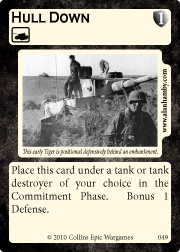
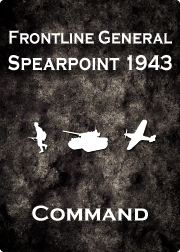 You may receive bonus modifiers for Defense, Attack, or Intensity, or use them to perform special Command functions such as withdrawing a unit, searching in Reserves for a unit you need in Combat right away, or drawing more Command Cards. In addition, a maximum of 1 Command Card may be discarded (burned) prior to rolling any roll in the game to influence the roll's result by +1. This way if you draw the Fighter Ace Command Card but have no Aircraft in your Reserves Deck, you still have a use for that card.
You may receive bonus modifiers for Defense, Attack, or Intensity, or use them to perform special Command functions such as withdrawing a unit, searching in Reserves for a unit you need in Combat right away, or drawing more Command Cards. In addition, a maximum of 1 Command Card may be discarded (burned) prior to rolling any roll in the game to influence the roll's result by +1. This way if you draw the Fighter Ace Command Card but have no Aircraft in your Reserves Deck, you still have a use for that card.
Damage Cards have effects for each of the four unit types and are designed to be placed under the damaged unit so the appropriate effect is shown. These add a lot of flavor to what happens during battles so you’re not just sitting there pinging hit points away from units without any sort of reduction of effectiveness.
For a Standard Game, which represents a meeting engagement, the victory conditions are very simple. The first person to score 51 points worth of destroyed (or captured) enemy units or to be left unopposed by any enemy units for three consecutive turns is declared the winner!
Situation Games are another way to play Spearpoint 1943. Situations provide a specific scenario for players to set up, including specific Win Conditions, the potential to score bonus points for achieving secondary objectives, and more. Situations typically restrict the types of units that can be put into a Reserves Deck and provide players with special rules and some forces in play at the start of the battle. All Situations are available for download right here.
Once you have a handle on the rules you should be able to play through a Standard or Situation game in about 30 minutes making this an uber wargame filler!
For even more depth using the same core Spearpoint 1943 combat rules and components, check out our terrain expansion for Spearpoint 1943.
Enjoy!
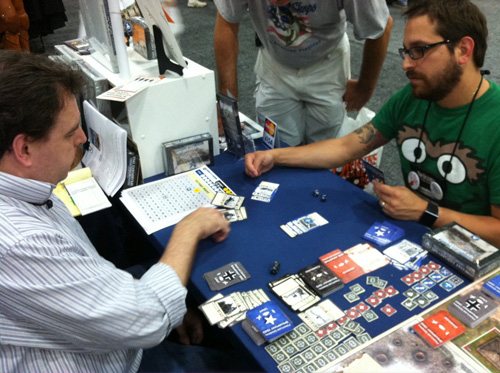 Spend 5 minutes learning how to play Frontline General: Spearpoint 1943 and you'll have the basics. The single rules sheet is direct and easy to follow, making learning the game (and teaching it) a snap. We'll be posting some video tutorials here soon to provide a more visual learning option. For now, we recommend checking out Marco Arnaudo's video review (linked in the Reviews Tab), which also gives a great overview of how the core mechanics of Spearpoint 1943 work. In addition, you can download the rules from the Downloads Tab as well as an FAQ that covers some special game situations. We encourage you to read through both documents. When you're ready to play, to get started with deck construction, we offer several pre-constructed deck suggestions for your first few games. After a few Standard games, be sure to try the 9 free Situations (Scenarios),which are also available in the Downloads Tab.
Spend 5 minutes learning how to play Frontline General: Spearpoint 1943 and you'll have the basics. The single rules sheet is direct and easy to follow, making learning the game (and teaching it) a snap. We'll be posting some video tutorials here soon to provide a more visual learning option. For now, we recommend checking out Marco Arnaudo's video review (linked in the Reviews Tab), which also gives a great overview of how the core mechanics of Spearpoint 1943 work. In addition, you can download the rules from the Downloads Tab as well as an FAQ that covers some special game situations. We encourage you to read through both documents. When you're ready to play, to get started with deck construction, we offer several pre-constructed deck suggestions for your first few games. After a few Standard games, be sure to try the 9 free Situations (Scenarios),which are also available in the Downloads Tab.
We fully support our games. If you ever have any questions about how to play, please get in touch with us through the game's forums on Boardgamegeek.com or direct by e-mail.
Download Rules, Situations, and other files for Frontline General: Spearpoint 1943 below. Most files are Adobe PDF format and require Adobe Acrobat Reader to view them.
Rules and Situations
| Title and Link | Version | Change Log | File Size |
|---|---|---|---|
| Frontline General: Spearpoint 1943 Rules | 1.0 | N/A | 4 Mb |
| Frontline General: Spearpoint 1943 Rules (Spanish Version) 1 | 1.0-SP | N/A | 4 Mb |
| Frontline General: Spearpoint 1943 Rules (Japanese Version) 7 | 1.0-JPN | N/A | 32 Mb |
| Situations Package (1-9, Zipped) | Latest (all) | N/A | 7 Mb |
| Situations Package (Travel Size, 1-8) 2 | Latest (all) | N/A | <1 Mb |
| Situation I - Take out those 88's | 1.1 | Summary | <1 Mb |
| Situation II - Beachhead Air Defense | 1.0 | N/A | <1 Mb |
| Situation III - One Chute Open! | 1.0 | N/A | <1 Mb |
| Situation IV - Capture that Bridge | 1.0 | N/A | <1 Mb |
| Situation V - Choke Point | 1.0 | N/A | <1 Mb |
| Situation VI - Disabled Tank | 1.0 | N/A | <1 Mb |
| Situation VII - Village Assault | 1.0 | N/A | <1 Mb |
| Situation VIII - Sniper! | 1.0 | N/A | <1 Mb |
| Situation IX - German Airfield | 1.0 | N/A | <1 Mb |
| Situations I, II (Spanish Version) 1 | 1.1-SP | N/A | <1 Mb |
Other Files and Player Aids
| Title and Link | File Size |
|---|---|
| Preview and Sample Game (please use latest rules) (originally published in FG News Issue 14) |
13 Mb |
| Rules FAQ | <1 Mb |
| Card List | <1 Mb |
| Starting Deck Suggestions | <1 Mb |
| Starting Deck Suggestions - Travel Size 3 | <1 Mb |
| Errata | <1 Mb |
| Tuck Boxes for Cards 4 | <1 Mb |
| Quick Reference Cards 5 | <1 Mb |
| Score Card / VP Track 6 | <1 Mb |
- Note 1: Spanish Translation provided by Miguel Angel Maroto de Lis.
- Note 2: Travel Size Situations provided by BGG User Joel Eddy. Print out, trim to fit original box.
- Note 3: Starting Deck Suggestions - Travel Size provided by Joel Eddy. Print and trim to fit original box.
- Note 4: Tuck Boxes courtesy Dustin Boggs. Instructions for use: Print on a heavy card preferably with an inkjet printer. There are a lot of darker tones on the box which lasers have a hard time reproducing. Glossy paper will print better as well. DO NOT scale when printing and print with a vivid or high colour setting for best results. Then fold and place original unsleeved cards in the appropriate boxes.
- Note 5: Quick Reference Cards courtesy d bro. Instructions for use: Player Aid sheets with concise rule summary designed to fit in the game box. Print sheets, fold lengthwise and trim to approximately 3.5" x 5.5". Laminate folded sheet so that you have 2 sheets front and back.
- Note 6: Spearpoint 1943 Victory Point Track courtesy Davide Galloni. Instructions for use: Print, then add a few tokens to track score, overrun, and turns for Standard and Situation based games.
- Note 7: Japanese translation provided by Suzuki Takuya.
Special Thanks to Joel Eddy, Dustin Boggs, d bro, and Davide Galloni for creating and sharing some excellent bonus content. Great work guys!
Links to External Reviews
Video Review by Marco Arnaudo (Great Video Overview of Spearpoint 1943 as well)
Review by The Gaming Gang (Source: thegaminggang.com)
Review by Roger Leroux (Source: BGG)
Review by Richard Mataka (Source: Mataka.org)
Review by John B (Source: BGG)
Review by Doug Andrews (Source: BGG)
Review by The View from the Turret Blog (Source: viewfromtheturret.com)
Review by Andrew Tullsen (Source: BGG)
Video Review by Lance Richardson (Source: youtube)
Gallery of Spearpoint 1943 In Action
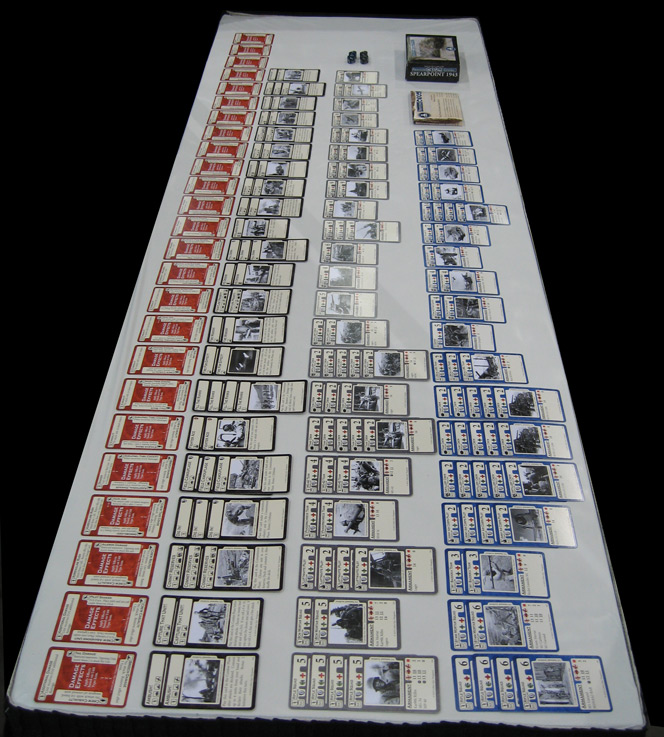
Spearpoint 1943 Gameplay at Origins 2010 and all Spearpoint 1943 cards.
General Frequently Asked Questions
Below are frequently asked general questions about this game. For a rules-related FAQ, please see the linked Rules FAQ file in the Downloads Tab.
Q: What is the level of difficulty of this game?
A: Easy to learn, easy to play.
Q: What is the level of abstraction of this game?
A: A fair amount of abstraction is used to keep the rules very simple.
Q: Is this a "hardcore" wargame simulation?
A: No, the design is light and simple, and intended to be quick to set up, fun to play, and highly portable.
Q: What is the "luck factor" of this wargame?
A: Some cards in the game are randomly drawn and there is a fair amount of dice-rolling for combat resolution.
Q: Is this a good introductory wargame?
A: Absolutely. You could consider Spearpoint 1943 a gateway wargame.
Q: Does it really just take 30 minutes to play, including setup?
A: Yes. 30 minutes is based on players knowing the rules. The first couple of games may take a bit longer.
Q: How much replayability does this game offer?
A: Infinite. Standard games let you customize every game through deck-building. Scenario games offer objectives for players but still include a deck-building element. Every game is completely unique- even with the same initial setup, and each game tells a story.
Q: Is this a collectible card game (CCG)?
A: No. Everything you need is in the box and all boxes are the same. It is however expandable through new add-on games like Spearpoint 1943: Eastern Front.
Q: Where can I purchase this game. In our online store directly (we ship worldwide) or through many US and international retailers. We have distributors in the USA, UK, Canada, France, and Germany.
